We get a lot of questions regarding suspension on these cars… A LOT of questions. It seems most people out there have found a reason to modify the suspension on their Z for one reason or another. Most guys lower their cars and end up needing to make further modifications to compensate for it. Others simply want to refresh their stock suspension to replace worn components.
I wanted to discuss what the various components we need to worry about in our suspension are, what they do, and what to replace them with. A lot of this will be common knowledge to some, but to others it might be brand new information, so let’s start from the top!
Alignments
The main goal with replacing suspension components is almost always to correct the car’s alignment in some capacity. There are a few properties that make up the car’s alignment settings, but these are the most important:
First up is camber. The camber setting affects how “inward” the top or bottom of the wheel sits in relation to the ground. As you can see in the above diagram, negative camber makes the car look like it’s squatting, and positive camber looks ridiculous. A car with 0° of camber would have the wheels perfectly straight up and down; perpendicular to the ground. Generally, most cars, especially sports cars, will have a small amount of negative camber from the factory, around -1°. It’s a bit improper, but when people talk about “adding camber,” they usually mean reducing the value–that is, making it more negative. When you lower a car, you’ll end up with more camber (see what I did there?), and how much is dependent on the car’s suspension geometry.
As camber deviates away from 0°, it will affect tire wear. Negative camber will cause the insides of the tires to wear quicker than the outside, and positive camber will cause the outsides to wear more quickly. Negative camber is sometimes (often) necessary for aftermarket wheel/tire combinations to clear fenders, too.
Next up is toe. This affects how inward/outward the wheels appear to be. Usually, this will refer to the front wheels, but the rears have a toe adjustment as well which is just as important. Most cars will have this set pretty neutrally. Toe-in will make the car feel a bit more stable, but can lead to tire wear. Toe-out will make the car feel a bit more “twitchy” and ready to change directions, but it will also lead to tire wear (and often, a bit more tire wear than toe-in). The same is true for the rear, and having an incorrect toe setting in the rear will make the car very squirrely and jumpy.
Finally is caster. This affects the way the wheels turn in relation to one another, as well as how the steering wheel “auto corrects” after you complete a turn. Generally, we don’t need to change the caster setting, other than to make the wheel sit evenly in the wheel well.
Component Construction
Those are the three main adjustments we’ll be talking about in this article. Before we dive in to the car specifics, I also want to point out a few ways these components can be constructed. From the factory, virtually every joint is going to be a rubber bushing. Rubber bushings generally offer the most comfortable ride, because it will deflect from shocks and bumps, but because they’re softer they’re not going to give you as much feedback, nor will they hold components as strongly as some other options.
In this picture of a Nissan OEM Rear Upper Control Arm, you can see that the outer joint uses a rubber bushing.

The OEM suspension arms virtually all use rubber bushings with an inner collar fused to the rubber. The rubber twists and deflects as the arm travels.
Most suspension arms are going to replace these with spherical bearings, also known as heim joints or pillowballs. Some consider to these as solid or semi-solid joints. These are usually constructed with a layer of teflon cushioning the inner and outer portions of the joint. Low quality joints wear our quickly and lead to slop in the component, but high quality joints feel great on the road (I would argue as good as bushings for certain arms) and last a long time. These are often the most expensive component of an arm, so cheaper arms often skimp on the quality of the joint.
One advantage to these arms is they do not resist movement like bushings do. In a setup where all of the bushings have been replaced with heim joints, including those at the spindle/knuckle assembly, the hub is able to freely travel up and down, and any and all force is put directly on the strut (shock+spring assembly). This can really improve the way the car feels, especially under competitive driving.
Another common option here are urethane bushings. These are effectively set up the same way as stock rubber bushings, but urethane is going to be stiffer than rubber, for the good and bad. You’ll get more feedback as a driver, but it will provide a harsher ride as well. Some urethane joints also allow the inner collar to “free spin” inside the bushing which will improve the ride quality a bit.
There are a few arms that only need to rotate on one axis, rather than two. With these, roller bearings are common. In the Z32 world, this will most commonly be found on the Front Upper Control Arms.
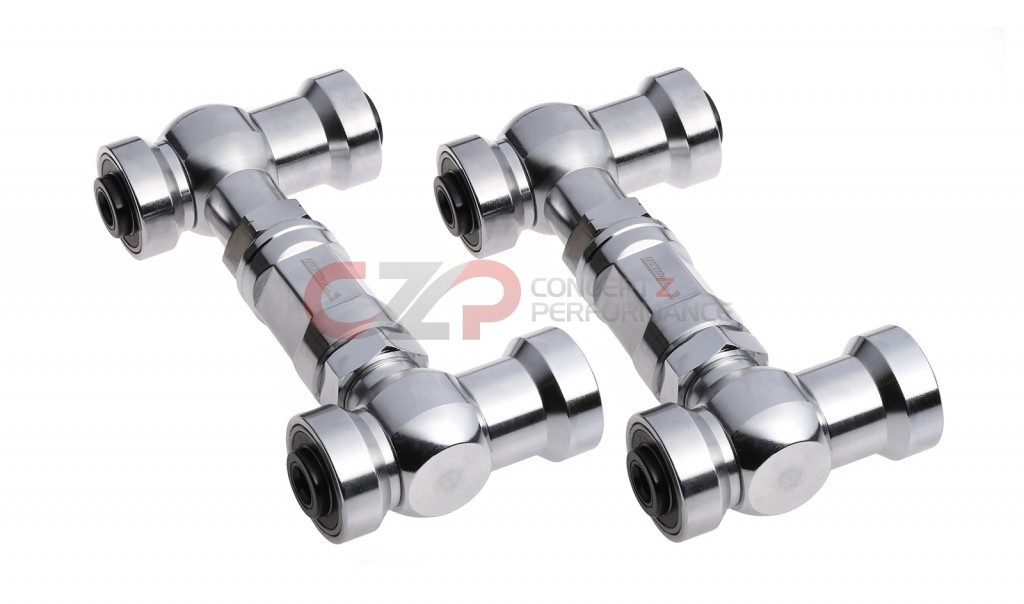
Powertrix Front Upper Control Arms. Note the roller bearings which will only allow rotation around one axis.
On the 300ZX
Now that we’ve established what our alignment does, and how some of the components are constructed, we can talk about how these apply to the Z32. First, let’s take a look at the front suspension. The front is the same for NA and TT.
So, the diagrams are labeled, but just to be clear, here’s what each component does:
Front Upper Control Arms – Adjusts camber in the front. The stock arms use rubber bushings, as the “upright” will actually try to twist slightly as it travels up and down, and rubber bushings allow that. Additionally, since the tension rod controls the caster (front-back movement) of the spindle, the upper control arm needs to allow a little bit of deflection laterally. For these, I usually recommend either Z1 Street (they use urethane bushings that allow a little of that pivot), Powertrix Extended (great for super low cars), or even Top Speed if you don’t need anything special.
Tension Rod – Adjusts caster. Generally, if you upgrade to different upper control arms, they’re going to have roller bearings. Almost all on the market do. For this reason, you normally have to change tension rods at the same time. Because the roller bearings in the upper control arm won’t allow forward-backward movement, the tension rods must be set at a length to match their position. Since stock isn’t adjustable from the factory, aftermarket becomes a necessity. Tension Rods are one you really don’t want to cheap out on. As the name implies, they are under a lot of tension, and the cheaper ones’ bushings always fail quickly. I like SPL, VooDoo13, and SPC (for a like-stock replacement with adjustability).
Not pictured are the tie rods, which are considered part of the steering system. Those are always adjustable from the factory, by design, and allow you to adjust toe. If your car is super low, though, different outer tie rods can be beneficial, as they’ll allow the tie rod to sit in a position more parallel to the ground. This helps reduce “bump steer” or “toe steer,” which is the sensation that the car is getting pulled to one side when the suspension travels on that side. For these, check out SPL Outer Tie Rods.
The lower control arms also would allow you to adjust camber, if they were adjustable. But adjustable versions are very rare, and not really necessary, for how common the FUCA is. It does, however, have rubber bushings which will wear out, and a ball joint as well. Additionally, the upright virtually never gets replaced, as it pretty much never goes bad. Nissan says the kingpin (the bearing in it) will make a “growling noise” when it goes bad. I very rarely see this actually happen.
Rear Suspension
For the rear suspension, I have two diagrams for you. Most of it is the same between TT and NA, but the TT has HICAS 4-wheel steering, so it has a HICAS Rack and tie rods, much like a front steering rack. The NA has a more traditional setup, using a toe arm instead.
For adjustability, it isn’t necessary to replace the HICAS rack on Turbo models. Like the front steering rack, the toe setting is adjustable by design, and you have more range of adjustment than you’ll ever need. This is not always true with the NA, however, as it uses eccentric bolts to adjust. These are basically bolts with egg-shaped washers on them, so their rotation determines the positioning of the arm in relation to the chassis. If the suspension is drastically modified, those bolts might not be able to get it in spec, so you would need something adjustable. In my opinion, SPL is the best option hands down.
Rear Upper Control Arm – This is the most commonly replaced part, and it controls the camber adjustment. This one’s not so picky, but like with any part avoid the cheap ones so you don’t have heim joints failing prematurely. With the S14, Nissan changed the design to be a “half circle” so it can more easily be replaced without removing the shock. Now, SPL and VooDoo13 both make arms that mimic this design. You have an eccentric bolt for the RUCAs from the factor, as well, but it’s rarely enough to get the alignment in spec if the car is lowered in any way.
Also, the traction rod or traction arm will give you slight toe adjustment, though not as much as toe arms or the HICAS tie rods. For this reason, it’s not often replaced unless you’re doing a track car and/or trying to get rid of OEM rubber bushings. It can also help reduce wheel hop under hard acceleration, especially if your stock bushings are worn.
Finally, like with the front, the rear control arms are rarely replaced, though some opt to change out their bushings for something different. I should point out that, while Nissan has a different part number for the NA and TT RLCAs, the only difference is the durometer (stiffness) of the rubber bushings. They’re otherwise interchangeable, and I’d be hard pressed to be able to feel a difference. I’m also fairly certain that the Nismo RLCAs are just silver TT RLCAs…
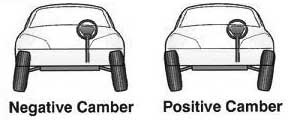
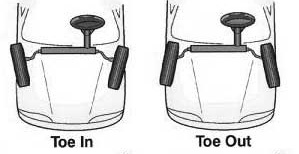
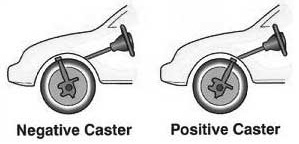

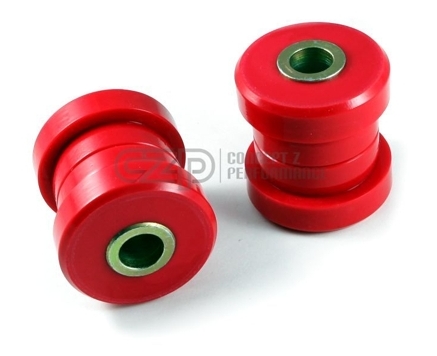

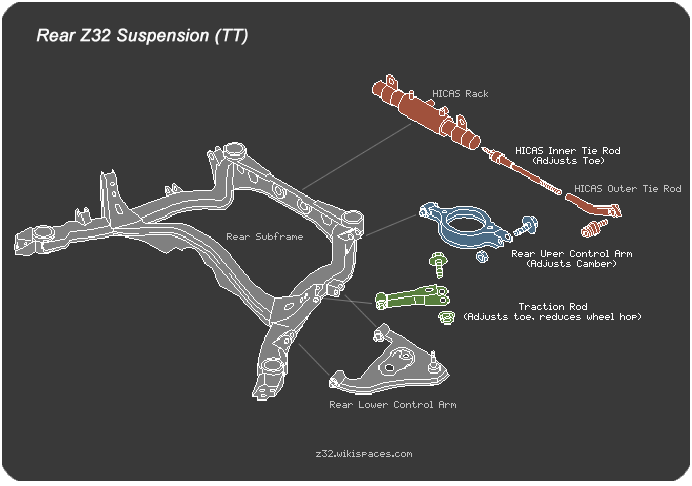
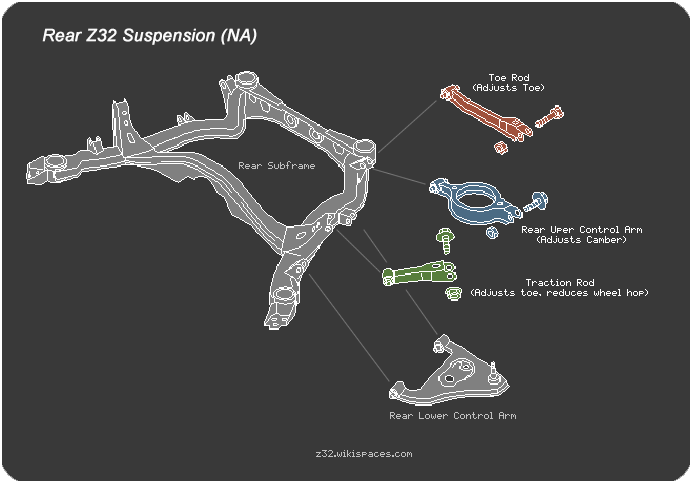
Another good article, Nick. Although ball joints don’t affect adjustability, what impact do they have on ride and ride quality?
Are you referring to the ball joints found at the lower control arms? Those are going to be pretty much standard for any car, and don’t often get replaced (though there are some arms that replace them with heim joints). They’ll ride pretty much the same, but of course if your ball joints are bad, it’s going to chew up your tires and give you a lot of slop and play in the suspension.
Thanks for the article, very informative.
Really good article, nicely compiles information that is otherwise quite fragmented around the net. Would’ve saved quite a bit of time, when I was changing my suspension arms. 🙂
Excellent info. Thanks
Thank you for giving me an article to reference when i tell people about alignments on driver. People just dont seem to ‘get it’. If you could add a bit about static alignment angles, it may be a bit more in depth, but the article is great, thanks.
Great article. Would you please provide a write up of the components necessary for HICAS removal. What additional suspension parts do you recommend?
It can really be done with something as simple as a HICAS eliminator bar, which basically just takes the place of the rack:
https://conceptzperformance.com/powertrix-hebnisz32-hicas-eliminator-nissan-300zx-90-93-twin-turbo-tt-z32_p_1397.php
These kits usually include bypass fittings that let you remove the HICAS solenoids in the engine bay. You can also switch to a Non-turbo power steering pump setup (reservoir, pump, brackets, etc). The high pressure line going to the front power steering rack can stay the same.
Alternatively, you can switch to a kit like this for the rear:
https://conceptzperformance.com/spl-pro-hicas-eliminator-brackets-w-bolts-and-bushings-90-96-z32-spl-hcb-z32-kt_p_10178.php
This effectively converts the rear to use NA-style Toe Arms. You would then need to pick up a set of adjustable toe arms to use in place of the HICAS tie-rods. SPL also makes a kit that includes all this for you:
https://conceptzperformance.com/spl-hck-z32-titanium-hicas-eliminator-nissan-300zx-90-96-z32_p_6974.php
But, it’s worth noting that the above SPL kits don’t include a bypass fitting for the hydraulic side (by the pump), so you would either need to switch to an NA setup or source one of those fittings separately:
https://conceptzperformance.com/czp-hicas-eliminator-hardware-kit-fits-powertrix-top-speed-z1-nissan-300zx-90-93-z32-55710-hrdkt_p_20525.php
Hope this helps!
Nissan still overlooks the beauty and superiority of its 240z rear setup
Great read, thanks. I’ve lowered my z32 a little and in turn, I have negative camber so I’m looking to get adjustable fuca’s front tension rods and ruca’s. The only problem I have is the what to buy bit. I want a fairly decent and none ‘crashy’ ride. I see a lot of people recommending the Z1 street fuca’s. But, I havent a club what will be good for the tension rods (but I’m thinking perhaps the matching Z1) and the rear, I just don’t seem to find any that will retain a decent feel and no one has really recomended any that can do this. Can you help?
For info, the car is a JDM TT. It has (or will have when I fit it) the hicas eliminator kit from driftworks.
Many thanks,
Lee
Well, the Z1 Street FUCAS do use bushings, so you have some options there. I don’t carry the Z1 Tension rods but those would pair well with them for sure. You could also do SPCs if you want something like-stock:
https://conceptzperformance.com/spc-67720-front-adjustable-tension-rods-nissan-300zx-90-96-z32_p_9454.php
But, outside of that, you CAN go with a traditional pillow-ball tension rod, so don’t rule out VooDoo and SPL, too.
Figured this may be the place to explain my problem and find a answer. 1993 300zx 2seater non turbo manual transmission. My problem is if I take a sharp turn or hit a dip n the road my steering wheel will become side ways and the car remains straight. So as I drive my stern wheel is turn to 3 o clock but my car remains straight.
Hey Joshua, this sounds like you need new steering rack bushings!
Thanks Nick, but what about the rear? I don’t mind a firm ride, but don’t want anything too hard or crashy
The rear doesn’t tend to affect the ride comfort too much, at least if you’re only doing rear upper control arms, but you can do Whiteline if you want something as close to stock as possible:
https://conceptzperformance.com/whiteline-kta118-adjustable-rear-upper-control-arms-nissan-300zx-z32_p_16457.php
Is there any beneift to use lower control arm to adjust camber (for both front and rear) instead of upper control arm?
Eh, not really. The only real advantage would be if you want to play with the effective offset of the spindle, since by adjusting both upper and lower, you could move the entire spindle inwards or outwards.
Being a complete newbie when it comes to suspension, this article was an amazing find! Thanks so much!!
Glad you liked it!
Thank you so much Nick. I have a few questions still. I have the front handled but my problem is the rear. Do i need to replace the control arms, tra ction rod and toe arm?
On the NA, toe arms are a good idea for toe adjustment, as the stock eccentric bolts won’t be able to get you in spec once it’s lowered. If it’s a TT this isn’t necessary because you have tie rods on the HICAS rack so you have plenty of adjustment there anyway. The rear upper (Camber) arms are the big requirement for adjusting that once it’s lowered. Traction arms will also give you some toe adjustment, but they’re kind of secondary. The only other real advantage to those is to stiffen things up and reduce wheel hop under hard acceleration.
what about stiffer sway bar?
Hi Nick reed your comments and it was good. I have questions about how to press out the ballpoint on the hub for the hicas, do I need to press out the inner shell to change too a hi as lock out bar. What is the best solution too do? Can I have your lock the inner rod or should I have a complete hicas lock out? Regards Sten Brandstrom Sweden.
Nick, what can be done to cure bump steer in the rear in hicas equipped Zs?
I’d just delete it! If the car is significantly lowered, you might be able to create some kind of spacer to move the rack upward or something.
Thanks for the article. My question is about struts. I have 88K miles and replaced the front struts. Do I need to do the rears as well? Would it really improve the ride quality?
Struts are one of those things that don’t really need to be replaced until they go bad. So if your rears aren’t leaking, they don’t necessarily have to be replaced yet. But it also stands to reason that if the fronts needed to be replaced, the rears probably aren’t far behind.
Thanks for the reply! As a followup, for a TT with 88K miles and assuming its been under “average” driving habits, would you have any recommendations on any specific suspension services to improve ride quality and handling? (OEM parts)
Nick, I have a ’92 TT Z32, 75k miles, with some vibration around 60mph that resolves at higher speeds. Tire balanced last summer. Now, peripheral edge wear noted on tires with low mileage but about 5 years old. Early on in 1990’s my dealer noted improper alignment and replaced 2 tires without charge. Dealer mechanic now states the tension rods need replacement. I’m concerned that the dealer mechanic may not know how to properly align this car. Dealer states mechanic has 20 years experience. Is the 300ZX difficult to align and do I need a 2nd opinion? thanks
Usually bad tension rod (bushings) will cause vibration under braking, but not normally during just cruising. Absolutely possible, but they’re non-adjustable anyway, so if they’re worn they need to be replaced. I would probably start there if they’re visually damaged (they’ll look wet once they go bad) if nothing else.
With this you will want to check the drive shaft center support bearing and your transmission mount. Both of those are wearable items, and often lead to vibration in the car. Though it will NOT come from the steering wheel but rather feel under the mid section of the car. Also check for bent wheels.
Nick – great article, very clearly articulated and straight to the point.
I just picked up a 1-owner, unmolested 1993 Z32 Coupe NA. 77K miles, no rust,…
I’ve since replaced the shocks/struts/bushings, sway-bar end links and tension rods. My next step is this:
* FLCA – tempted to buy just the bushings and ball joint and learn how to press them in/out – would you recommend this? (goal is to save costs)
* FUCA – is it possible to press in/out these bushings and reuse the FUCA?
Rear components – hoping to do the same with all of the rear components (press in/out the bushings).
I’m only interested in keeping the stock ride and will not be tracking this car.
Are replacing these bushings worth the effort if so, what’s tke order you would attack this problem?
Hey Peter, for the FLCA I would absolutely just replace the bushings and ball joints. You’ll need access to a hydraulic press, so you can either pick one up, find a shop that allows you to use one, or just find a shop to do the work for you. It would be a walk in the park for them.
For the FUCA, if you’re keeping things stock, you can just do bushings. I would probably do Whiteline since they’re fairly close to stock feeling.
For rears, Energy Suspension makes a complete rear bushing kit that’s pretty good bang for your buck too!
Hi Nick. Thanks for the info. Sorry if I’m a little late but I have a question. When I make a sweeping turn, like getting on an HWY ramp that curves around, at one point in turning the car aggressively cuts in as if the rear is turning in. I can go back and forth across that point with the steering wheel where it’s traditional turning then sharp un-predicted turn in.
It’s a 1991 NA Z32 with BC coilovers, Z1 FUCA’s, Pillowball RUCA and Adj Toe arms, all new Energy suspension bushing front, rear and front swat bar and new ball joints all the way round.
Alignment done and front/rear toe are in spec and front -1.8 camber and rear -1.0 camber.
I just completed this setup and have been having this aggressive turn in issue. I also marked the camber bolts and they don’t seem to be moving out of place. They aggressive turn is it only at one pint of steering.. Any advice would be helpful. Thanks in advance.
You might be experiencing a bit of bump steer, but normally you’d only feel that as you pass over bumps while turning. I would guess your caster is too aggressive, and it’s causing the tire to “roll” a bit partially through the turning arc.
Thanks Nick for the quick reply, sorry didn’t see it.. I was thinking same but didn’t know how bad out of spec caster could affect. Mine is severely out spec bit still positive. I also was thinking bump steer but the surface was flat as you said. My Caster is at 6.9*, didn’t think that was horrible. The max and min target on the sheet say 10.5 and 9.0. Suggest buying adjusting tension rods?
Nick – I have a 90 NA, and just replaced my tension rods, had an alignment, and road-force balanced my wheels. I’m still experiencing a steering wheel shake above 55mph that gets worse with speed, but sometimes goes away for a few seconds on a straight, smooth road. I’ve also noted the steering feels a little loose at higher speeds. Any advice would be appreciated. Thanks
Hi Casey, it’s rare but it’s possible this can be caused by play in the rack, or in the tie rods, though usually you’d expect someone to catch wear like that when doing an alignment, but not always. Also, if you have aftermarket wheels, you might need to add hubcentric rings.
Wow…this article was a great read, and I appreciated the down-to-earth explanation too!!